Key takeaways
- Activist teacher resources empower students to engage with real-world issues, fostering critical thinking and a sense of responsibility for social change.
- Service projects promote empathy, collaboration, and practical life skills, allowing students to see their impact on the community and grow personally.
- Effective project planning involves clear objectives, student involvement, and logistical preparation, ensuring rewarding and meaningful experiences.
- Mentorship should balance support and independence, creating an environment that encourages resilience and personal growth through challenges.

Understanding activist teacher resources
Activist teacher resources are more than just lesson plans or handouts; they are tools shaped by passion and purpose. When I first explored these resources, I realized they could transform classrooms into spaces of empowerment and critical thinking. Have you ever noticed how a well-chosen resource can ignite a student’s curiosity and commitment to social change?
What strikes me most about these materials is how they connect learning to real-world issues. They encourage students to question, challenge, and act, rather than passively consume information. It’s like handing them a map and a compass for navigating complex social landscapes—something I’ve found invaluable in my own teaching journey.
Sometimes, these resources also serve as a mirror, reflecting injustices that might otherwise remain invisible. I remember feeling a profound sense of responsibility when a student’s perspective shifted after engaging with such content. Isn’t that the true power of activist teacher resources—to open eyes and hearts simultaneously?
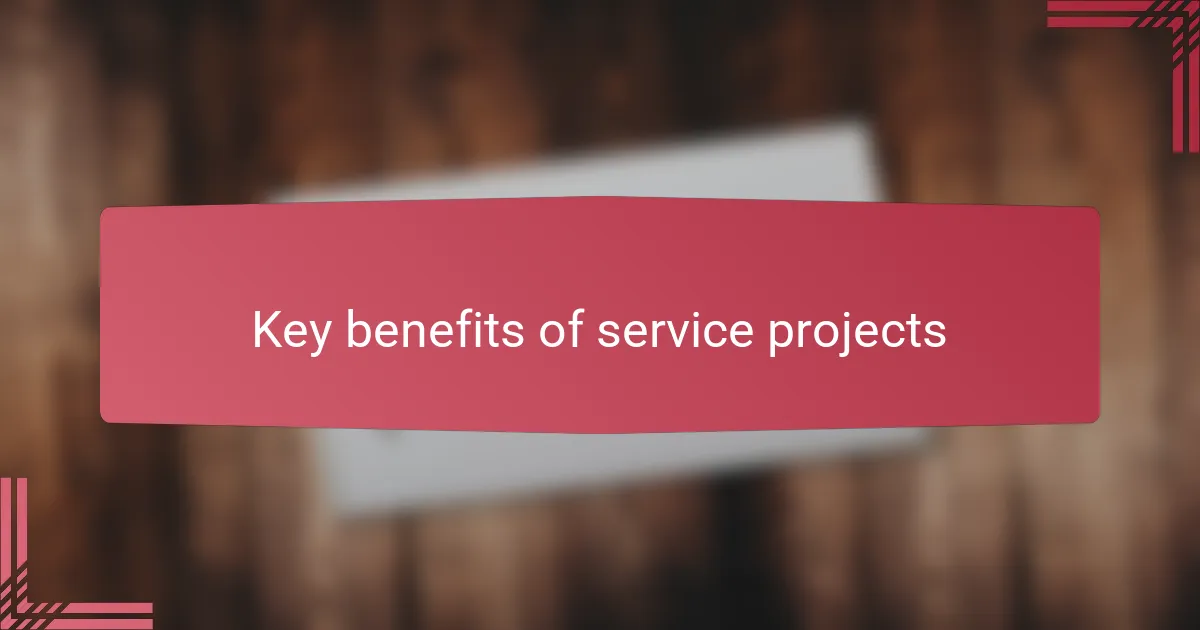
Key benefits of service projects
When I first started guiding students through service projects, I quickly saw how these experiences fostered a deep sense of empathy. There’s something powerful about watching a student realize that their actions can genuinely impact others—it shifts their perspective in a way that textbooks alone never could. Have you ever noticed how hands-on involvement opens hearts and changes mindsets more effectively than any lecture?
Another benefit I’ve seen is how service projects nurture critical life skills like collaboration and problem-solving. Students learn to navigate challenges together, often uncovering strengths they didn’t know they had. I find it rewarding to witness these moments of growth; it’s as if the project becomes a mini-lab for real-world learning that goes beyond academic achievement.
Lastly, service projects create a lasting connection between students and their communities. They start seeing themselves not just as learners, but as active participants in shaping a better world. This sense of responsibility is contagious—it spreads from one student to another and, sometimes, it even transforms entire classrooms. Doesn’t that kind of engagement make teaching feel truly meaningful?
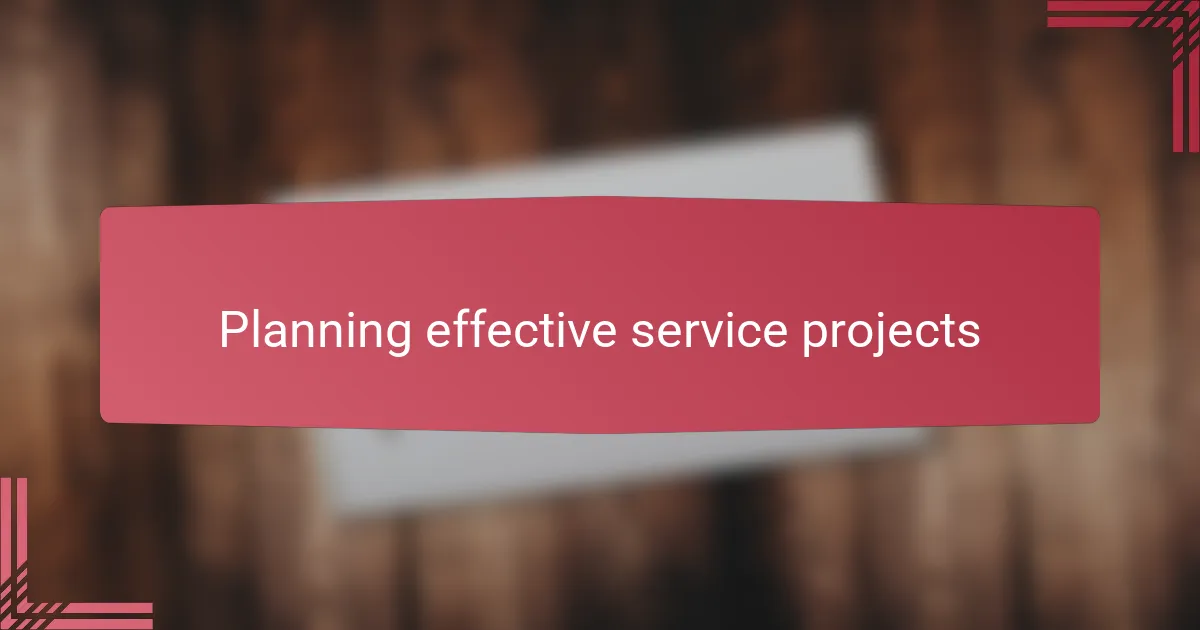
Planning effective service projects
Planning effective service projects means starting with a clear purpose that resonates both with the community’s needs and the students’ passions. I remember once working with a group who was eager to address environmental issues, but without a focused plan, their efforts felt scattered. Have you ever jumped into a project only to realize halfway through that the goals weren’t aligned? That’s why I always emphasize setting specific, achievable objectives before diving in.
Another thing I’ve learned is the importance of involving students in the planning stages. When they help identify problems and brainstorm solutions, their ownership and motivation skyrocket. It’s incredible to watch their confidence grow as they see their ideas take shape into real actions. Doesn’t it make the entire journey more meaningful when students lead the way?
Finally, mapping out logistics ahead of time saves so much stress later. Finding the right partners, setting timelines, and anticipating challenges creates a smoother path for everyone involved. From my experience, the projects that felt most rewarding were the ones with a thoughtful plan guiding each step. Have you noticed how preparation transforms uncertainty into excitement?
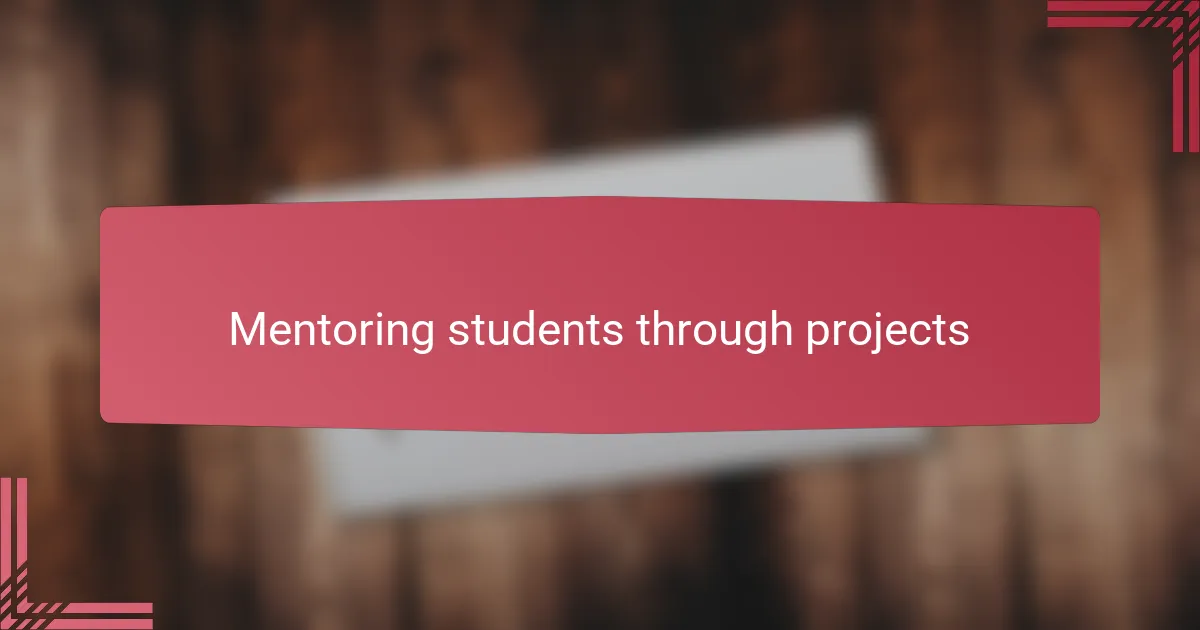
Mentoring students through projects
Mentoring students through projects has been one of the most rewarding parts of my teaching experience. I’ve found that offering guidance without taking over lets students develop their own voice and confidence. Have you ever seen the spark in a student’s eyes when they realize, “I can do this”?
It’s crucial to balance support with independence, especially when challenges arise. I recall a moment when a group hit a major roadblock, and instead of jumping in with solutions, I asked them what they thought should happen next. That pause created a space for problem-solving that made their eventual success feel truly earned.
What’s fascinating is how these projects become living classrooms—dynamic, unpredictable, and deeply personal. Watching students reflect on their progress and setbacks reveals growth that extends far beyond the project itself. Isn’t that what meaningful mentoring is all about?
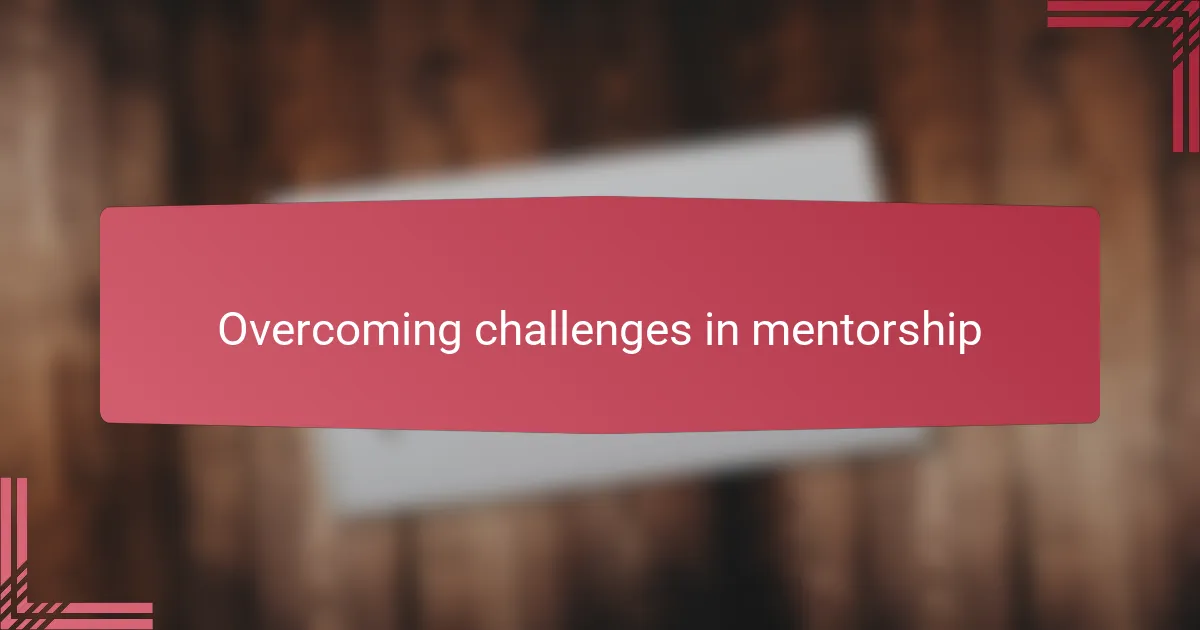
Overcoming challenges in mentorship
Challenges in mentorship often come unexpectedly, like when enthusiasm meets unforeseen obstacles. I remember guiding a student through a project that suddenly lost community support; it was frustrating, but instead of stepping in to fix everything, I encouraged them to brainstorm alternatives. Have you ever experienced that moment when a setback becomes a powerful lesson in resilience?
Sometimes, the toughest part is balancing encouragement with giving space. I’ve found that pushing too hard can backfire, yet stepping back too much leaves students feeling unsupported. Finding that sweet spot is a constant learning process—and honestly, it has made me a more patient mentor.
Communication hurdles also pop up more than you’d expect. At times, students hesitate to admit confusion or fear failure, which can stall progress. Creating a safe, open environment where questions are welcome helped me break down those walls, turning challenges into growth opportunities. Isn’t that exactly what mentorship should feel like?
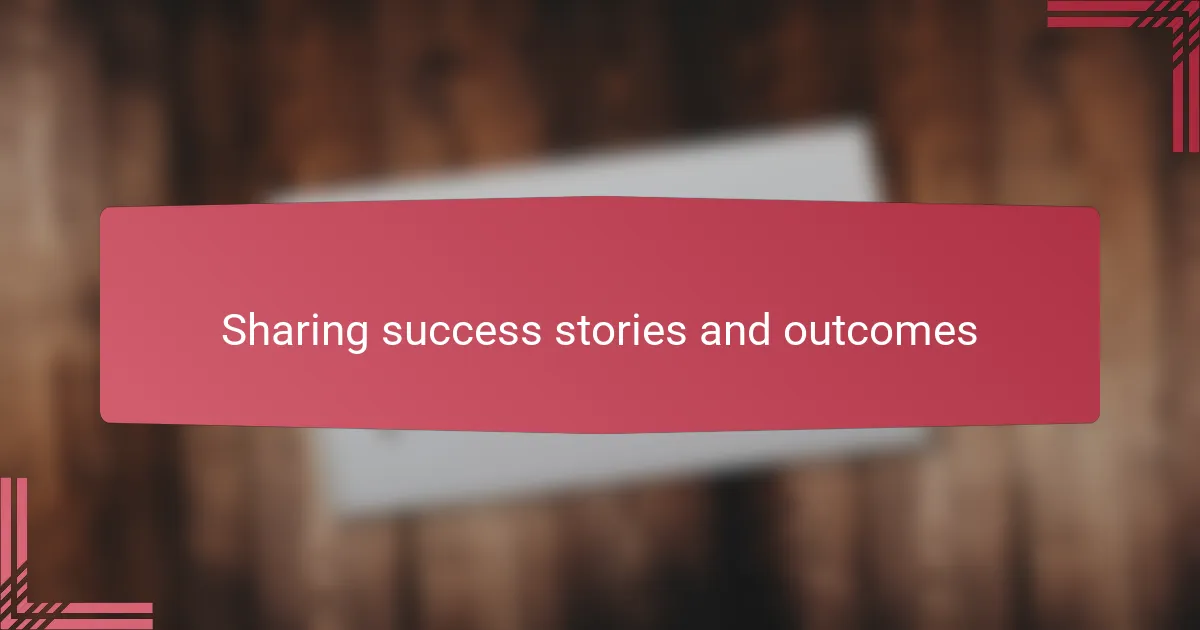
Sharing success stories and outcomes
Sharing success stories has been one of the most fulfilling aspects of mentoring service projects. I recall a student who initially doubted their ability to make a difference, yet after presenting their project’s impact to the community, their confidence blossomed in a way I hadn’t anticipated. Have you ever noticed how celebrating these moments not only boosts the students but also reinforces the value of their work?
Highlighting outcomes helps students see the tangible effects of their efforts, which is essential for sustaining motivation. When I share feedback from community members or show how a small action sparked a larger change, it feels like planting seeds that will grow beyond the classroom. It’s amazing how those real-world results become a narrative that students carry proudly, shaping their identity as changemakers.
I’ve also found that sharing stories encourages reflection, allowing students to connect what they learned with who they are becoming. After one project, my group wrote personal narratives about their experiences, revealing insights about empathy and responsibility I hadn’t fully realized. Isn’t it wonderful when success is measured not just by outcomes but by personal growth too?
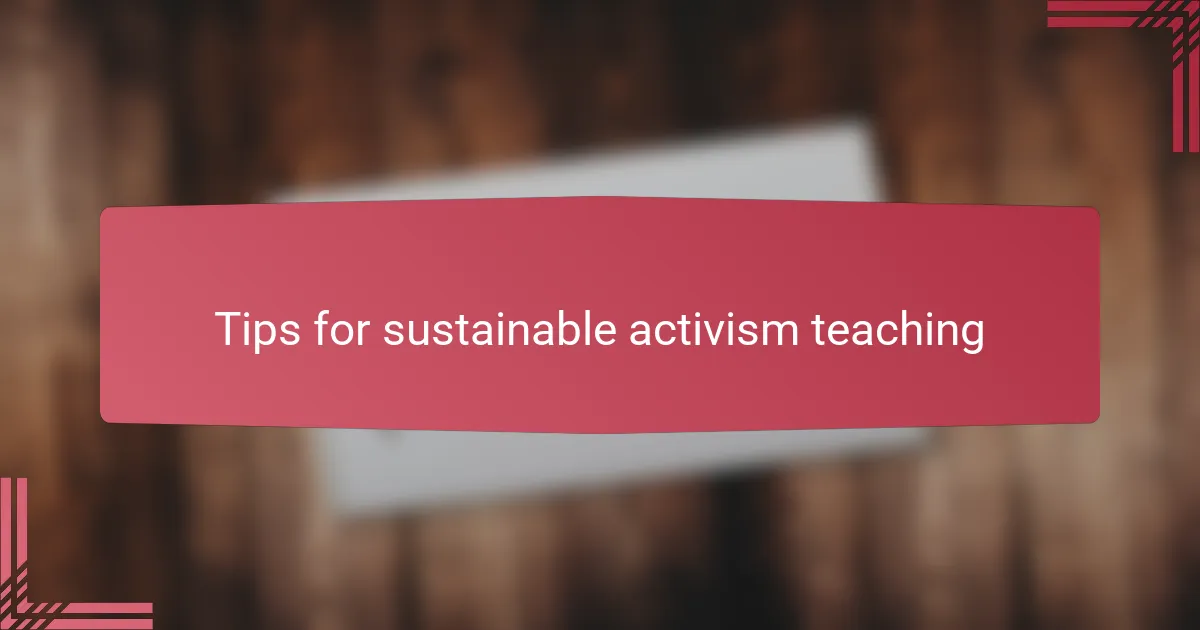
Tips for sustainable activism teaching
Sustainable activism teaching, to me, means pacing the journey so students don’t burn out. I’ve seen projects lose steam when enthusiasm masqueraded as urgency—have you noticed how lasting change requires patience as much as passion? Slowing down to build true understanding and commitment is often what keeps activism alive beyond a single classroom moment.
Another thing I’ve learned is the importance of embedding self-care and community care into activism. When I reminded my students to pause and reflect during intense projects, they returned more energized and thoughtful. Isn’t it powerful to model that caring for ourselves and others is a vital part of sustained action, not a distraction from it?
Finally, I try to encourage activism that adapts with experience rather than sticking rigidly to plans. Flexibility has been my saving grace when unexpected obstacles appeared in projects—it teaches students that resilience is the backbone of ongoing change. Have you ever noticed how the most enduring movements are those that listen, learn, and evolve over time?